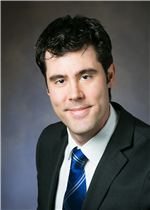ChE Seminar: Dr. David W. Flaherty
| Event Date: | March 26, 2019 |
|---|---|
| Speaker: | Dr. David W. Flaherty |
| Speaker Affiliation: | University of Illinois |
| Time: | 3:00-4:15 pm |
| Location: | FRNY G140 |
| Contact Name: | Davidson School of Chemical Engineering |
| Open To: | Attendance required for PhD students |
| Priority: | No |
| School or Program: | Chemical Engineering |
| College Calendar: | Show |
Dr. David W. Flaherty, Assistant Professor, Chemical and Biomolecular Engineering & Dow Chemical Company Faculty Scholar, University of Illinois, Urbana-Champaign
 Dr. David W. Flaherty
Dr. David W. Flaherty
Assistant Professor
Chemical and Biomolecular Engineering
Dow Chemical Company Faculty Scholar
University of Illinois
Part of the Fall 2018 Graduate Seminar Series
"Why Does the Catalyst Need to Be Wet? Active Sites, Activities, and Non-Innocent Solvents"
Learn more about Dr. Flaherty at: https://chbe.illinois.edu/directory/profile/dwflhrty/
Bio
David Flaherty is a Dow Chemical Company Faculty Scholar and Assistant Professor of Chemical and Biomolecular Engineering at the University of Illinois, Urbana-Champaign. He earned his B.S. in chemical engineering from the University of California at Berkeley and his Ph.D. in chemical engineering from the University of Texas at Austin with Buddie Mullins. He was a postdoctoral scholar at the University of California, Berkeley with Prof. Enrique Iglesia. In December 2012 he joined the faculty at the University of Illinois, Urbana-Champaign. He leads a group that develops understanding and design principles for the use of solid catalysts to resolve challenges for the sustainable production of chemicals and energy carriers. Research focuses on generating new insight to the chemical phenomena that emerge when reactions occur at complex surfaces and at liquid-solid interfaces. Knowledge of these systems comes from the combined use of kinetic, spectroscopic, and synthetic methods to develop principles needed to create increasingly selective catalytic systems by exploiting diverse chemical interactions. Current projects focus on the production of environmentally benign oxidants, sustainable selective oxidation of hydrocarbons, and conversion of biomass-derived species into valuable chemicals and fuels. Prof. Flaherty is the recipient of the CAREER Award (National Science Foundation), the Early Career Research Award (American Vacuum Society), the Doctoral New Investigator Award (ACS-PRF), the Dean’s Award for Research Excellence (College of Engineering, UIUC), and serves as a Program Chair for the North American Catalysis Society Meeting in 2019. Additionally, he has been named five times to the UIUC “List of Teacher’s Ranked as Excellent”, received the School of Chemical Sciences Excellence in Teaching Award in 2015, and selected as an “Outstanding Advisor” multiple times by the Engineering Council at UIUC.
Abstract
Solvating molecules and the environment that surround catalytic sites provide numerous interactions that dramatically affect catalysis and change rates and selectivities by orders of magnitude. Although the importance of solvent effects on organic chemistry is established and provides widely used “rules of thumb”, the interactions among solvent molecules and reactive species remain challenging to quantify and describe molecularly. These challenges are compounded when solvents not only restructure about intermediates at active sites but also sense the presence and functionality of solid-liquid interfaces that extend beyond active sites. Understanding and exploiting these phenomena requires a conceptual framework, rooted in principles familiar to chemical engineers, and informed by experimental methods that probe the reactivity of intermediates, the structure of the catalyst, and changes in the solvent at the reactive interface during catalysis (i.e., in situ). This lecture will illustrate these challenges by revealing the complexities of catalytic systems relevant for the synthesis of environmentally benign oxidants and their use in creating valuable chemical building blocks from hydrocarbons. The direct synthesis of H¬2O2 (H2 + O2 → H2O2) proceeds on Pd catalysts that evolve both in response to the composition of the reactants and the solvent. Here, solvent molecules can participate as co-reactants (e.g., redox mediators) but also as co-catalysts in processes that involve proton-electron transfer steps. Once formed, H2O2 and other peroxides are co-reactants for the catalytic epoxidation of alkenes, which proceed at early transition metal active sites stabilized within the framework of zeolites. The epoxidation reactions are sensitive to the electronic structure of the active sites that lead rates and selectivities that increase by 105- and 102-fold, respectively, with the electron affinity of the metal center. Yet, these reactions also depend on the dimensions and polarity of surrounding pores, because these surfaces change the structure of the solvation shells that form about reactive species and evolve along with the reactants. Comparisons of the results from kinetic, thermodynamic, spectroscopic, and synthetic experimentation provide insight to the coupled molecular interactions between catalyst surfaces, solvating molecules, and reactive species from which we can extract principles to design solid-liquid interfaces for catalysis. Moving forward, these principles may enable the development of new chemistries and processes for the selective oxidation of light hydrocarbons.
